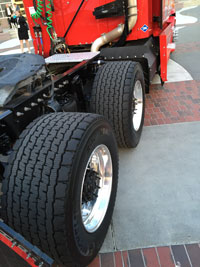Vehicle Parts and Equipment to Conserve Fuel
Only about 12%–30% of the energy put into a traditional combustion engine goes toward its propulsion on the road—especially in modern vehicles. Most of the energy is lost to engine and driveline inefficiencies, like exhaust heat, or is used to power accessories like air conditioning. Vehicle fleet managers and drivers can conserve fuel and maximize their operational efficiency by driving efficiently and outfitting their vehicles with commercially available equipment designed to save fuel. Implementing fuel-efficient strategies, systems, and programs for some or all vehicles can help fleets monitor and better manage their vehicles, vehicle-related costs, and carbon footprint. These strategies are cost-efficient and do not require extended vehicle downtime.
Aerodynamic Equipment and Vehicle Design

By reducing the drag, or resistance, imposed on a vehicle traveling at high speeds, aerodynamic equipment eases the load on the engine and improves the fuel economy of a vehicle. Airfoils, trailer gap reducers, side skirts, under trailer devices, aerodynamic splash guards, and tails are examples of aerodynamic equipment that fleets can install on trucks to reduce driveline losses. Airfoils direct air over the cab, trailer gap reducers lessen air turbulence by minimizing the space between the cab and the trailer, and side skirts limit the air that circulates under the trailer. Under trailer devices channel air to reduce turbulence, aerodynamic splash guards reduce drag compared to traditional splash boards, and tails reduce the turbulent airstreams dragging behind the trailer. EPA's SmartWay program provides lists of verified aerodynamic devices.
Many light- and heavy-duty vehicles (HDVs) that manufacturers are developing have streamlined vehicle designs that reduce drag. More information on aerodynamic tractor and trailer equipment for HDVs can be found in NACFE's Confidence Reports.
Idle Reduction Equipment
Idle reduction technologies reduce the amount of time an engine idles unnecessarily. Auxiliary power units, bunk heaters, batteries, and other idle reduction equipment can help reduce idling and save fuel. EPA's SmartWay program provides lists of verified idling reduction technologies for trucks and school buses. A number of tools developed by Argonne National Laboratory, such as the Idle Reduction Savings Calculator and the Alternative Fuel Life-Cycle Environmental and Economic Transportation (AFLEET) Tool, help fleet managers and drivers calculate the time they idle and the environmental benefits of idle reduction equipment, allowing them to identify the most cost-effective ways to improve their idling profile and potential savings.
Fuel-Tracking Devices and Telematics Systems
Data collection devices installed in vehicles can track fuel economy, maintenance schedules, and fleet performance to help fleets monitor fuel consumption, improve fuel economy, and increase asset utilization. For example, the Public Service Company of New Mexico’s fleet installed a telematics system to monitor fleet performance, track driver behavior, and inform driver training. With these devices, the fleet improved their average fuel economy by 15%.
Electronic logging devices automatically record hours-of-service and driving time data and are required on certain commercial buses and trucks. Through the use of global positioning systems and communication technologies, telematics provides fleet managers with data about vehicle location, vehicle use and miles driven, idle time, fuel economy, driver behavior, and engine maintenance requirements. Many of these telematics systems are paired with powerful software packages or driver training programs to help track vehicle activity and manage fuel consumption. Some devices give drivers real-time fuel economy feedback, which has proven effective in reducing fuel use. Other devices can also provide data to help fleets make informed decisions about maintenance and vehicle replacement.
To determine what telematics systems data to focus on, a fleet should identify its top priorities, such as idle reduction or efficient routing. The fleet can then work with a telematics provider to determine key performance indicators and extract the most important data. This planning will help the fleet use the data to deliver efficiency improvements. For example, in a telematics deployment study with the Marine Corps fleet, researchers at the National Laboratory of the Rockies (NLR) calculated the total savings from telematics for various light-duty vehicles and shuttle buses. When used in the Marine Corps fleet, telematics had the potential to help fleet managers save more than $2,000 per vehicle each year. Also, learn how NLR used telematics to help five fleets explore the benefits of obtaining electric vehicles.